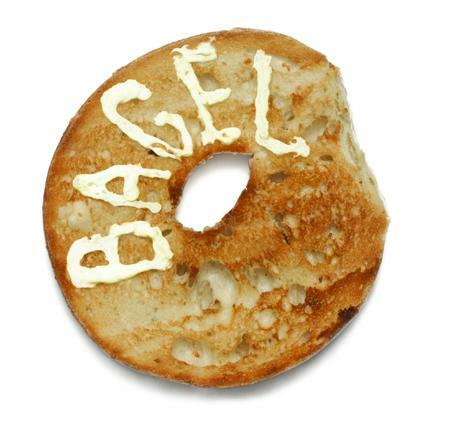
Well Said: Gezunt zol zayn der vos hot oysgetrakht beygl esn (Whoever thought of eating bagels should live and be well )
- Written by:
- Asya Vaisman Schulman
- Published:
- Fall 2013 | 5774
- Part of issue number:
- 68

A few days before Rosheshone (Rosh Hashanah) this fall, I went to the bakery section of my local supermarket to buy challah for the holiday. The supermarket had set up a special display table where rolls and round loaves, with and without raisins, surrounded the centerpiece: a small pyramid of honey-soaked dough balls garnished with nuts and candied fruits and wrapped in plastic. The labels had the bakery’s logo, the product’s kosher certification, a list of ingredients, and a name: Teiglach. No translation nor description in English was provided to explain this Yiddish word to the uninformed consumer. I wondered how many shoppers in this generic grocery store in western Massachusetts had ever heard of teiglach or knew what they were. To satisfy my curiosity, I posted a query online to my friends around the country, asking if the non-Yiddish speakers among them were familiar with this word. Predictably, only a few of my Jewish friends (mostly living in the New York area) could correctly identify teiglach as the gooey dessert usually eaten on Rosheshone, a time when custom calls for eating honey to ensure the sweetness of the New Year.
What my friends were not aware of is that the word teiglach is not just the name of the pastry but actually quite a descriptive term—it literally means “small pieces of dough” in Yiddish (spelled teyglekh according to the YIVO system of transliteration). In the singular, teygl is a diminutive form (a construction used to convey smallness) of the word teyg, meaning “dough”; thus teygl is “a small piece of dough.” A bit of further research revealed that the word teiglach has actually entered the English language and can be found in both the Oxford English Dictionary, which cites a number of English-language sources dating back to 1903, and the American Webster’s Third New International Dictionary.
This informal investigation started me thinking about the origins and meanings of other Yiddish food words used in English. While we’re on the topic of desserts, let’s look at rugelach (rogelekh; the change in the English spelling of the initial vowel from “o” to “u” reflects the southern dialect of Yiddish). At first glance, it might seem that the makeup of the word for these crescent-shaped pastries is similar to that of teiglach. The -ekh suffix clearly indicates a plural form, which is attached to rogele, seemingly the iminutive (second degree diminutive) of rog, meaning “corner.” The etymology in this case, however, is a bit more complex. As it turns out, there is a very similar pastry in Slavic cuisine called rogal or rogalik, from rog, meaning “horn” (reflecting the hornlike shape of the food); -al, a suffix that forms nouns; and -ik, a Slavic diminutive suffix. To the ear of a Yiddish speaker, the –al sounded quite similar to the familiar diminutive form, and thus the word morphed into rogele, with the plural rogelekh.
Probably the best-known baked product with a Yiddish name is the bagel (beygl). This doughnut shaped bread roll is such a common food item thatmany Americans probably aren’t even conscious of its Yiddish origins. While the exact etymology is difficult to trace (various sources suggest that it comes from the Middle High German Böugel, meaning “ring”), it is clearly related to the verb beygn —“to bend.” If we consider how the bagel is made—a roll of dough is bent into a circle until the two ends connect—the term makes perfect sense.
The final food word that I’d like to discuss is one that has recently received national attention and has been the object of some controversy—knaidel (kneydl in YIVO transliteration). You may have heard that it was the winning word in the 2013 Scripps National Spelling Bee, which uses spellings found in Webster’s Third. The word for this dumpling (also known as a matzo ball) comes from the Middle High German term for a similar food, Knödel, which in turn is a diminutive of Knote, meaning “knot”.
Whether you prefer yours light and fluffy or dense and heavy, kneydlekh (“knaidlach” according to Webster’s) are a delicious addition to any bowl of chicken soup. Add a beygl on the side and some rogelekh and teyglekh for dessert and you have yourself a whole sude (feast). Est gezunterheyt! (Eat in good health!)
Asya Vaisman Schulman is director of the Yiddish Book Center’s Yiddish Language Institute. She has taught Yiddish at Harvard University, Indiana University, and Hampshire College.
